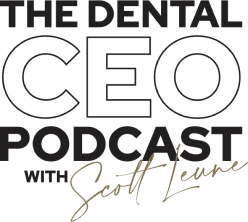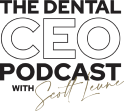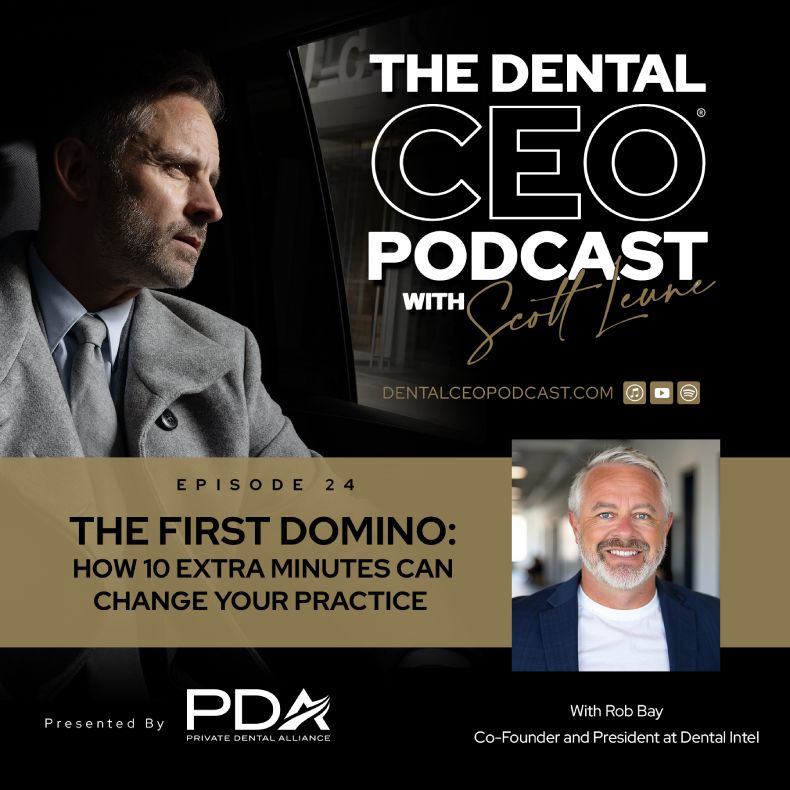Dental CEO Podcast 36 – The Staffing Formula Every Dental Practice Should Follow
In the latest episode of the Dental CEO podcast, host Scott Leune dives deep into the essentials of staffing for startup dental practices and how to evolve as they mature. This comprehensive guide is an indispensable resource for dental practice owners aiming to optimize their operations and grow sustainably.
Highlights
- Initial staff setup for startup practices includes minimal staff to match patient flow and incorporates virtual assistants.
- Staffing expansion should consider booked conditions and patient flow to reduce no-shows and cancellations.
- Optimal staffing ratios for mature practices featuring a combination of on-site and virtual staff tailored to operational needs.
- Considerations for scheduling and staffing as the practice expands, potentially accommodating multiple doctors.
- The importance of maintaining a balance in staffing to support each doctor adequately, ensuring the practice’s success.
Speakers

Dr. Scott Leune
Scott Leune, known as The Dental CEO, is one of the most respected voices in dental practice management. From his seminar room alone, he has helped launch over 2,000 dental startups and supported more than 20,000 dentists across practices worldwide. Named one of the 30 Most Influential People in Dentistry, Leune delivers practical, no-fluff strategies that empower dentists to lead with confidence, scale efficiently, and achieve real personal and financial success.
Watch Episode
Read Full Transcript
Have you ever wondered what the perfect way is to staff a young dental practice? A startup practice or a practice that's just getting off the ground? Maybe it's a slow practice you've purchased. We need to reset your expectations on what good staffing looks like. And that is exactly what we're diving into today on the Dental CEO podcast.
To have this conversation, I think the best way is to use the example of a startup practice. A practice that starts from nothing and grows. How do we expand the employee base to the point where we're a mature practice? Even if you already have an existing practice, you're somewhere on this journey. Understanding the healthy flow of employee expansion is important because you might be out of balance right now.
You might have too many employees in one area and not enough in another. You might be spending money in the wrong places. So let's walk through staffing levels using the example of a brand new practice that will eventually become a mature practice.
In a startup practice, when we open the doors, there aren't many patients. We have no recall patients, which in many practices make up three-fourths of the patient load. With a tiny patient flow, we don’t need many staff. We typically open with one column in the schedule, one dental assistant, and the dentist.
Before we talk front office, let’s focus clinically. I know the dentist could work out of two columns, but we only open one. That forces all patients into one column spread across the day. If we booked two columns, we’d end up rushing, staggering patients, skipping same-day dentistry, and feeling pressured to add a second assistant. I’d rather spread those visits across one column with one assistant so we stay on time and reduce stress.
Clinically in the beginning: one assistant, one column.
Now the front office side. This is where things get tricky. Whether you’re new or mature, you might have three or four calls come in at once. But you can't afford three or four front-office employees. Workload comes in waves, and we can’t staff to the peak.
So in a startup, we use one front-office person plus a virtual assistant. The on-site person works patient days plus extra administrative hours. The virtual person overlaps during the highest call-volume windows.
Let’s unpack that. The front office person works the three patient days, plus additional days to reach full-time hours. It’s hard to hire great people for only three days a week. We don’t yet have the patient volume to justify full-time clinically, but we do have the need for a long-term team member. Working capital funds the gap. They work full-time, they handle admin tasks, phones, walk-ins, and anything that supports patient flow.
Next, the virtual assistant. We want them full-time too. Luckily that cost is low in dentistry. Their schedule is built around call spikes — usually mid-day and late afternoon. So maybe they work 10–7 while the practice works 8–4. They overlap with the on-site person to strengthen phone coverage.
They’re not just answering phones. They verify insurance, confirm appointments, and process admin tasks. Their workflow runs continuously, and they pick up missed calls as they come in. This creates a safety net so we don’t lose new-patient opportunities. The on-site person handles priority tasks; the virtual person handles everything else.
That’s the initial startup setup: one assistant, one front-office person, one virtual assistant, no hygienist.
As we grow and get booked out a week, then two weeks, we have a problem. At two weeks booked out, no-shows increase, cancellations increase, and phone conversion drops. So before hitting the two-week mark, we expand. We open the second clinical column and hire a second assistant. That creates openings and relieves pressure. We don’t yet need more front-office support.
Then the doctor adds their full intended schedule — maybe quits a part-time associateship and moves to four or five days. That opens more availability and keeps things manageable with the same team: two assistants, one front-office person, one virtual assistant.
We keep growing, still doing our own hygiene, until we're close to booked out again. That’s when we hire our first hygienist, usually part-time. Ideally, we run assisted hygiene. The hygienist pulls hygiene off the doctor’s schedule to create openings. If hygiene overflows, the doctor still does hygiene when needed. We repeat this cycle — expand hygiene when volume demands it.
At maturity, the typical setup is one doctor working out of two columns with two dental assistants. Then three hygiene columns covered by two or three hygienists depending on whether assisted hygiene is used. In the front office, two on-site people plus a virtual assistant handle the volume of a five-op practice. One focuses on scheduling and patient reception, the other on billing and insurance. The virtual assistant handles verifications, confirmations, and EOB processing.
This ratio works well. One doctor can collect around two million with this model and take home about half. The team structure looks like this: two assistants, two front-office staff, two or three hygienists, plus virtual support.
If you want two doctors working at the same time, you need at least 10 ops because each doctor needs five. Two restorative ops and three hygiene ops per doctor. If you don’t have 10, the doctors cannibalize each other’s patient base and you operate at a lower flow.
If you don’t have enough ops, you must extend hours or stagger schedules. For example, with only five ops, two doctors could each work two-and-a-half days per week in extended hours. Or with seven ops, they could overlap some days. The key is that across the week, each doctor must average the equivalent of five full ops of support.
This creates complexity in staffing because some days you’ll need more assistants and others fewer. Similar complexity happens with front-office staffing. But this is part of running a multi-doctor practice. Don’t let that complexity distract you from the most important rule: every doctor needs enough support columns. If you don’t have enough hygiene, you can’t fill their schedules.
All of this started on day one with one assistant, one front-office person, and one virtual assistant. At peak capacity, each doctor needs: two restorative ops with two assistants, three hygiene ops covered by either three hygienists or two plus a hygiene assistant, and two front-office people plus virtual support.
With one doctor and five ops, that structure can produce at least two million in collections and at least one million in take-home pay.
Now go do the math. How many hygiene columns support your schedule? Is it enough? Add it up across the week. How many front-office people do you have? Do you have more than two per doctor? If so, you’re likely overstaffed. They may look busy, but busy doesn’t always mean effective. The right ratio is two front-office people plus one virtual assistant per doctor.
That’s our episode on staffing. I hope this gets you thinking. Maybe you need a reset. This topic matters for a lot of dentists.
Until next time, my name is Scott Leune, and this was the Dental CEO podcast.
SUBSCRIBE TODAY
Subscribe now and receive a 25% discount code for Scott Leune’s upcoming events. Plus, get podcast episode alerts and exclusive subscriber perks.




